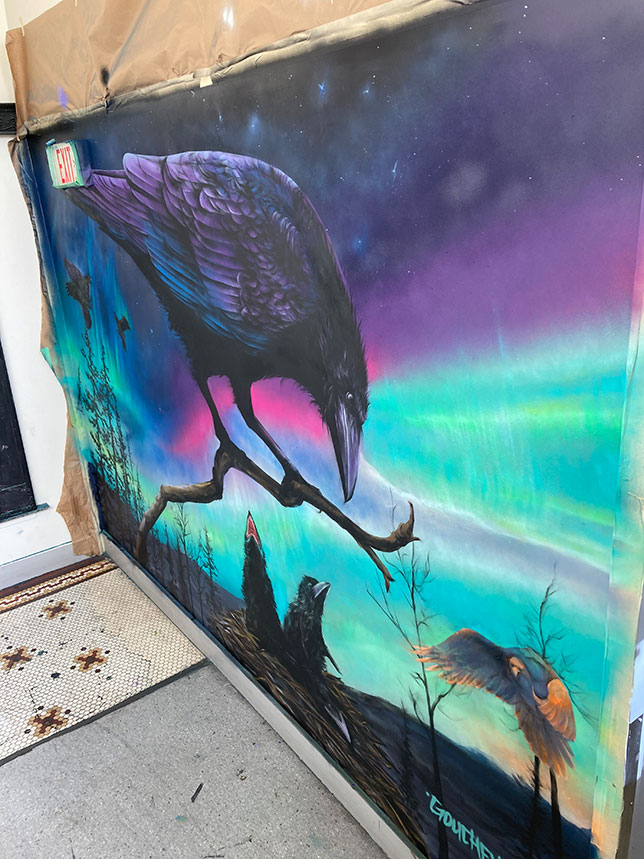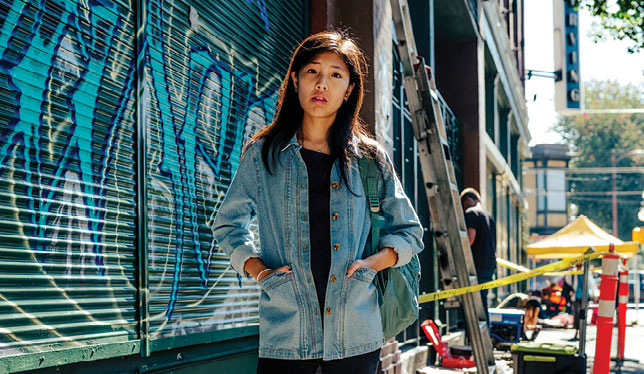Surrounded by a vast expanse of evergreen forests on three sides, scenic views of the ocean and within walking distance to the beach, the University of British Columbia’s campus is a world away from Vancouver’s Downtown Eastside, marked by disproportionately high levels of drug use, homelessness and poverty. But for UBC student Lianne Cho, the hotels along East Hastings Street have become the classroom, and its residents partners in a research project known as the Community Brain Art Initiative. Together with her research team, Ms. Cho is seeking to apply the findings from the Hotel Study – a 15-year UBC project that investigated the intersection of physical and mental health, drug addiction and access to public health providers – directly back into the community experiencing homelessness or precarious housing. “We’re doing research that aims to understand the experiences had in the community, and it’s really important to involve those voices – to physically go and have those conversations,” said Ms. Cho, who is completing her MD/PhD.
Funded by UBC’s Public Scholarship Initiative which encourages students to engage the public through innovative and non-traditional PhD formats, the project consists of three phases. The first involved creating infographics on what should be kept in mind while caring for individuals experiencing homelessness and distributing materials to clinicians and health care providers in the Downtown Eastside. Phase two took the form of facilitated community art sessions where residents could create visual art and engage in conversations about brain health. For the third and final phase of the project, Ms. Cho’s research team worked with local Cree artist Jesse Gouchey to design a mural conveying the themes that emerged from the art sessions. By supporting projects like hers, UBC’s Public Scholars Initiative is “sending the message that we’re invested in this community, and we want to be engaged and do good,” said Ms. Cho. “I think that message counts for something.”

It’s a message that a growing number of Canadian universities are sending through their own public scholarship initiatives. Concordia University in Montreal launched its public scholarship program in 2016, Dalhousie University in 2018, and Queen’s University selected its first cohort of public scholars this year. While definitions of public scholarship vary, it’s generally understood to involve a mutually beneficial partnership between university researchers and community partners. More than simply looking at engagement – which one would be hard pressed to find missing from any Canadian university strategic plan – public scholarship encourages academic researchers to partner with other sectors to serve the public good, whether not-for-profits, industry, or government. “It’s about building a structure of knowledge creation that is reciprocal,” says Fahim Quadir, vice-provost and dean of graduate studies at Queen’s. For some, public scholarship is a shift away from an elitist tradition in graduate education, where only select individuals who can afford to are invited to contribute to public knowledge, according to Dr. Quadir. “It’s not academia building an island and expecting community organizations to follow along – it’s the other way around,” he says.
That principle of co-creation has guided the Community Brain Art Initiative from the beginning, according to Ms. Cho. “Public scholarship is about keeping in mind how your research impacts the community, and letting that guide your research questions, design and communication of research findings.” Incorporating the knowledge and perspectives of community members – many of whom suffer from mental illness – has allowed her research team to better understand where more support is needed, and to communicate that to frontline workers in the community. Public scholarship enables that flexibility, or learning as you go as Ms. Cho puts it, to make sure “the needs of the community are at the forefront of what we’re doing.”
But beyond opening the gates to the ivory tower, public scholarship programs have also become part of a “reimagining” of doctoral education to better support the passions and career expectations of candidates. According to Statistics Canada, more than 60 per cent of PhD graduates in Canada find work outside of the academy, a reality PhD programs are currently not designed to reflect, according to Susan Porter, dean of graduate studies at UBC. “I’m sorry to say so, but it’s still not universally understood: we’re not cloning professors here,” says Dr. Porter, who led the design of UBC’s public scholarship program. “The fact is that our graduates are doing many more things than traditionally taught in the academy, and that was an important motivation for doing this: normalizing and legitimizing that.”
“It’s not academia building an island and expecting community organizations to follow along – it’s the other way around.”
In many cases, incorporating public scholarship into doctoral education also allows students to build on their own passions and interests, instead of simply replicating the work of their supervisor. “We’ve heard stories of students with tremendous backgrounds, working in amazing places, who were told to leave that at the door – because that’s not what we’re doing in the academy,” says Dr. Porter. “And that just breaks my heart. What power, what resources do these students have within them?”
Whether graduate students remain within or seek careers outside academia, tackling many of Canada’s biggest challenges – from public health to climate change – will require researchers to have a broad skill set that might not traditionally be associated with completing a PhD. While fundamental scholarship is essential, says Dr. Porter, a broadened view of doctoral education and scholarly output that incorporates creative or nontraditional dissertation projects allows space for students to be assessed on skills that include collaboration, the ability to connect with diverse audiences and to successfully share their scholarship with the world outside academia.
Such skills are the building blocks of Concordia’s public scholars program. As part of the application, doctoral candidates must complete a six-week strategic public communications course offered each winter. The training – which is open to all PhD students, not only those applying to the public scholars program – teaches students the fundamentals of research communication. Andréa Cartile, a doctoral student in mechanical engineering and 2021-22 Concordia public scholar, argues the training helps fill the skills gap that can come with choosing to specialize in the sciences. “Once you choose the science stream, in Canada at least, it’s like nothing else exists – it’s the experimental method, it’s statistics, that’s it,” she says. “We completely neglect the other side, the humanities.”
Public scholarship is one way in which academia can bridge the communications divide with the public. Discipline-specific language in academia is one of the main barriers to the public seeking to access academic research, according to Faye Diamantoudi, dean of graduate studies at Concordia. “Research is public by definition, there’s free access,” she notes. “But the way that we are communicating it and the way knowledge is traditionally disseminated is not understood by the wider public, and that has been the problem.” Dr. Diamantoudi emphasizes the program is not only about making research available, but also making it palatable and understood. “That’s public scholarship in my mind.”
For Ms. Cartile, who is completing her dissertation on modeling a framework to help inform a software tool to better understand aircraft design processes, complex jargon is something she understands quite well. Her research was sponsored by two Canadian aerospace companies, and throughout the public scholarship program, she exchanged knowledge between her lab and industry partners with the goal of simplifying how airplane manufacturing processes are communicated worldwide. “It’s totally inaccessible, but it’s more than that – there’s an onus to make things sound smart,” she says. “The academic structure is built on exclusion, right? That’s how the whole thing functions: we tell people you can’t be part of this, and then we reinforce that by using language that is also inaccessible.”
In contrast to UBC, Concordia’s program mandates its public scholars to “engage the community-at-large” by creating public-facing materials. This includes producing regular social media content, populating a public scholar profile page on Concordia’s website and engaging with the news media to publish their research. When the program first launched, the university partnered with the Montreal Gazette, Montreal’s main English-language newspaper, and has since expanded to include partnerships with Le Devoir and The Conversation Canada. “The basic idea is that we need to communicate to the communities we serve,” says Dr. Diamantoudi.
“Concordia is a publicly funded university – we have a mission to fulfill and we operate on taxpayer money. What are we producing? Why are we relevant?”
Not only does public scholarship remind society of the importance of research and the relevance of universities, but it also helps academic institutions build – or rebuild – trust with the public. The pandemic has brought this to the fore, according to Timothy Caulfield, Canada Research Chair in health and law policy in the faculty of law and the school of public health at the University of Alberta.
“In this era, with declining trust in institutions, it becomes important for academics to engage with the public because they can build that trust,” says Dr. Caulfield. Over nearly 30 years, Dr. Caulfield says he’s witnessed the “growing recognition of having an informed citizenry and having informed voices in the public discourse.” Public engagement, he argues, is a significant responsibility for academics, especially for those whose research is publicly funded.
Ultimately, the rise of public scholarship signals a necessary shift in the culture of the academy, says Dr. Porter. By bringing others into the process of knowledge creation, public scholarship “demonstrates respect for all parts of society that academia is meant to serve.”
For Lianne Cho, whose population group includes a relatively high number of Indigenous people, that lesson meant embracing and making space for Indigenous knowledge and perspectives. For instance, when the UBC team first suggested it create a visual representation of the themes that arose in the community art sessions, community members insisted that the artwork should not only be visually appealing, but also create a welcoming space for Downtown Eastside residents, many of whom are Indigenous. The vibrant mural, titled Pimohtêhon, meaning passage, or travel through life, depicts a raven at various stages of life, representing the four directions of the Cree medicine wheel that convey the importance of balancing the spiritual, emotional, mental and physical aspects of the self. “Art plays a big role in the emotional expression and storytelling of the community,” says Ms. Cho.
As she begins a new semester, Ms. Cho reflects on how the values of this diverse community informed her research. A model of public scholarship, the Community Brain Art Initiative is designed to be a long-term, sustainable project that will continue long after Ms. Cho has completed her MD/PhD. Its success would not have been possible without the input of many voices. “And that includes the community members and our partners, who aren’t in the academic space.”
